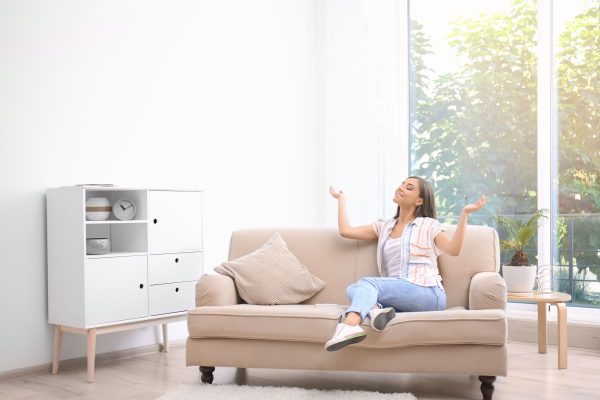How to Improve Indoor Air Quality in McAllen Custom Homes
When building your dream custom home in McAllen, Texas, creating a beautiful and functional space is just the beginning. A truly exceptional home also supports your health and well-being—and this starts with prioritizing Indoor Air Quality (IAQ).
Often overlooked, IAQ is a vital aspect of home design that affects everything from your physical health to your daily comfort and even long-term productivity.
In this article, let’s understand how you can design a custom home in McAllen that doesn’t just look great but also promotes a healthier lifestyle for you and your family.
Why Indoor Air Quality Is Crucial
You might think of pollution as an outdoor problem, but research shows that indoor air can be up to five times more polluted than outdoor air, even in urban areas.
The Environmental Protection Agency (EPA) identifies several sources that can negatively affect indoor air quality, including pressed wood products, pesticides, secondhand smoke, stoves, heaters, fireplaces, and volatile organic compounds (VOCs). And this is just the tip of the iceberg.
These pollutants can have serious health implications. In fact, research has shown a connection between air pollution and mental health. The Guardian reports that long-term exposure to even low levels of air pollution can contribute to conditions like depression and anxiety.
Americans spend a lot of their time indoors, breathing air that may contain pollutants like volatile organic compounds (VOCs), allergens, and mold spores.
| Pollutant | Source | Health Impacts | |
| Radon | Soil, foundation cracks | Lung cancer risk | EPA: Model Standards for Radon |
| Volatile Organic Compounds (VOCs) | Paints, adhesives, furniture, cleaning products | Eye/throat irritation, headaches, long-term organ damage | EPA: Indoor Air Quality |
| Carbon Monoxide (CO) | Stoves, heaters, fireplaces | Dizziness, nausea, potentially fatal in high doses | American Lung Association: Carbon Monoxide |
| Dust and Dust Mites | Carpets, bedding, upholstered furniture | Allergies, asthma | Mayo Clinic: Dust Allergy |
| Mold and Mildew | Moist areas, water leaks | Respiratory issues, skin irritation | CDC: Mold Guidelines |
Poor IAQ can lead to:
Short-term issues: Irritation of the eyes, nose, and throat, headaches, and fatigue.
Long-term problems: Chronic respiratory diseases, allergies, cardiovascular conditions, and even cognitive impairments.
In Mission, TX, where hot and humid weather often necessitates tightly sealed homes for energy efficiency, it’s easy for indoor pollutants to accumulate. That’s why addressing IAQ is not just a luxury—it’s a necessity.
Step 1: Optimize Ventilation

Ventilation ensures that stale indoor air is replaced with fresh outdoor air, diluting pollutants and maintaining a healthy indoor environment.
Ventilation serves as your home’s respiratory system, crucial for removing indoor air pollutants like carbon dioxide, VOCs, and excess humidity. Without proper ventilation, these contaminants can reach harmful levels, affecting your health and comfort.
Here is how you can optimize ventilation in a home for sale in McAllen, TX:
- Advanced mechanical systems
Install Mechanical Ventilation with Heat Recovery (MVHR) systems. These systems bring in fresh air while recovering energy from outgoing air, maintaining efficiency without compromising air quality.
- Natural ventilation
Design homes with cross-ventilation, placing windows on opposite walls to encourage airflow.
Use clerestory windows or transoms to create a “stack effect” that draws warm, stale air upward and out of the home.
- Demand-controlled ventilation (DCV)
Use smart systems that adjust airflow based on real-time occupancy and pollutant levels, ensuring consistent air quality without wasting energy.
Step 2: Eliminate Indoor Pollutants at the Source

One of the most effective ways to improve IAQ is by reducing pollutants before they even enter your home.
Here are some common pollutants to address:
- Volatile organic compounds (VOCs)
These harmful chemicals are emitted by paints, adhesives, furniture, and cleaning products. It is highly recommended to choose low-VOC or no-VOC options for paints, finishes, and adhesives. Also, opt for solid wood furniture instead of pressed wood, which often contains formaldehyde.
- Dust and allergens
Use an allergen-proof mattress and pillow covers to reduce exposure to dust mites. Also, regularly vacuum carpets and upholstery using HEPA-filter vacuums.
- Mold and mildew
Prevent mold growth by managing indoor humidity and ensuring adequate ventilation in wet areas like bathrooms and kitchens.
- Radon and carbon monoxide
Test your home for radon, an odorless gas that can seep through foundation cracks and is linked to lung cancer. Install carbon monoxide detectors near bedrooms and living areas to monitor this potentially deadly gas.
Step 3: Incorporate Filtration Systems

Filtration systems work alongside ventilation to actively remove pollutants from your home’s air.
- HEPA filters
High-Efficiency Particulate Air (HEPA) filters capture 99.97% of particles as small as 0.3 microns, including allergens, dust, and mold spores. Add these to your HVAC system, or use portable air purifiers.
- Air purifiers
Choose purifiers based on the room size. For instance, a 250-square-foot room would require an air purifier with a Clean Air Delivery Rate (CADR) of 161 or higher. Look for models that also target VOCs for even better IAQ.
- Filter maintenance
Regularly clean or replace filters—every 1-3 months for HVAC filters and 6-12 months for standalone air purifiers. Dirty filters can become sources of pollution themselves.
Step 4: Integrate Biophilic Design and Natural Solutions

Connecting your living space with nature not only elevates your home’s aesthetic appeal but also boosts IAQ. Here are some of the ways to do that:
- Air-purifying plants
Certain plants naturally remove toxins from the air. Consider adding:
- Snake Plants: Absorbs VOCs and produces oxygen even at night.
- Peace Lilies: Removes common toxins like benzene and formaldehyde.
- English Ivy: Effective against mold spores.
- Natural Materials and Light
Use natural materials like wood and stone, which release fewer VOCs compared to synthetic alternatives. Also, maximize natural light with large windows and skylights. The increased exposure to daylight improves mood and supports healthy circadian rhythms.
- Encourage natural airflow
Open windows daily for 10-15 minutes to refresh indoor air. You can also use ceiling fans to improve air circulation.
Step 5: Manage Humidity
In McAllen’s humid climate, controlling moisture levels is key to preventing mold growth and maintaining comfort.
Here is how to control humidity:
- Dehumidifiers: Use standalone or integrated systems to keep indoor humidity levels between 30-50%.
- Exhaust fans: Install these in kitchens, bathrooms, and laundry rooms to reduce moisture at the source.
- Weatherproofing: Seal cracks around windows and doors to prevent damp air from entering your home.
Step 6: Regularly Monitor Indoor Air Quality

Monitoring tools help you stay proactive by providing real-time data about your home’s air. Here are some recommended tools:
- IAQ Monitors: Track pollutants like VOCs, carbon dioxide, and particulate matter.
- Radon Test Kits: Essential for identifying and mitigating radon risks.
- CO2 and Humidity Sensors: Ensure balanced ventilation and moisture levels.
- Long-Term Benefits of Prioritizing IAQ
Actions for Better Indoor Air Quality in New Homes
If you have recently moved to a new home in McAllen or are in the process of moving, here are a few measures to adopt:
Implement radon-resistant construction techniques
Radon is a naturally occurring radioactive gas that can infiltrate your home through the foundation. It’s important to use radon-resistant construction techniques to keep your home safe.
You can obtain the EPA’s booklet, Model Standards and Techniques for Control of Radon in New Residential Buildings, from your state radon office, health agency, or homebuilders’ association. You can also visit the EPA’s Radon Resistant New Construction (RRNC) site for a step-by-step guide.
Choose low-emitting building materials and furnishings
Selecting the right materials is key to minimizing indoor air pollution. For example:
- Opt for exterior-grade pressed wood products made with phenol-formaldehyde resin for floors, cabinetry, and wall surfaces, or consider solid wood products as an alternative.
- If you plan to install wall-to-wall carpeting, particularly on concrete that is in contact with the ground (such as in basements), ensure a moisture barrier is installed before the carpet is laid. Avoid using permanent adhesives to attach the carpet to concrete so that it can be removed if it becomes wet.
Ensure proper drainage and seal foundations
Air entering your home through the foundation may carry more moisture than activities inside the house generate. Make sure the foundation is properly sealed and that the drainage is adequate to prevent moisture problems.
Consider mechanical ventilation systems
New home designs often incorporate mechanical ventilation systems, which help bring fresh outdoor air into the home. Some systems, such as heat recovery ventilators (HRVs) or air-to-air heat exchangers, are energy-efficient options that can improve air quality without wasting energy.
Vent combustion appliances properly
Appliances like furnaces, fireplaces, wood stoves, and heaters need to be correctly vented to prevent harmful gases such as carbon monoxide and particulates from backdrafting into the living space. Backdrafting is more common in weatherized or tightly constructed homes.
One solution is to install a dedicated outdoor air supply for combustion appliances to ensure they receive enough fresh air and are properly vented.
Design Healthy McAllen Custom Homes With Us!
Designing a McAllen custom home with indoor air quality in mind is more than a thoughtful gesture—it’s a commitment to your family’s well-being. By implementing strategies like enhanced ventilation, pollutant control, and natural design elements, you’ll create a living space that’s not only stunning but also health-conscious.
Ready to build a home that’s not just beautiful but also promotes your family’s health and well-being? Villa Homes specializes in creating custom homes designed with your health in mind. Contact us today to learn more.




